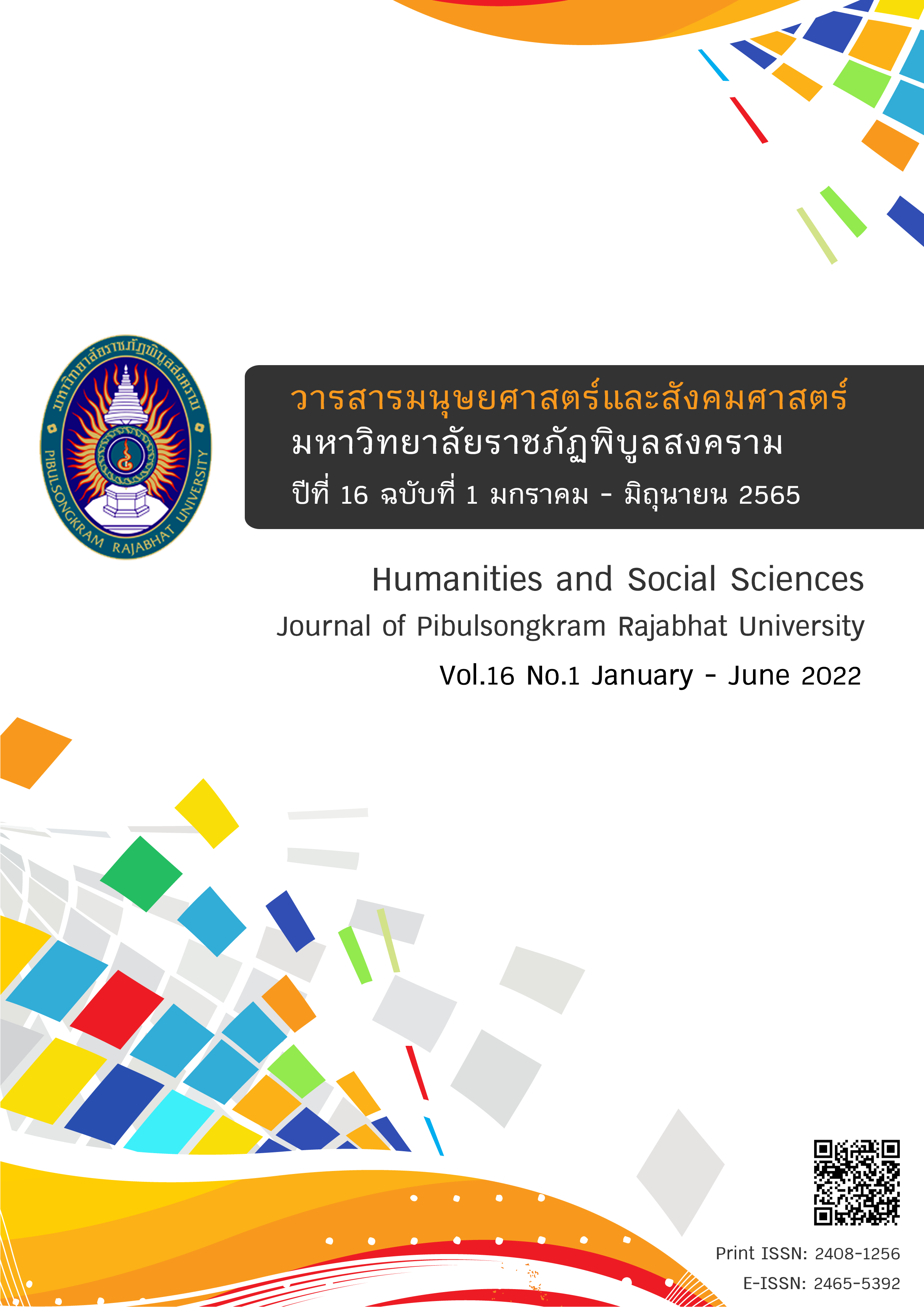Guidelines of Using CLIL in EFL Learning Management for Higher Education
DOI:
https://doi.org/10.14456/psruhss.2022.1Keywords:
Content and Language Integrated Learning, EFL, Higher EducationAbstract
The content and language integrated learning approach (CLIL) is a most popular approach in Europe, America, and ASEAN. Thailand has applied the CLIL approach to teach English at various levels, especially in Higher Education. Since it is an appropriate approach to teach language for communication, it fosters learners’ participation in enhancing knowledge and skills through cognitive processes by using English language as a medium for conducting a variety of activities. It also promotes the use of language skills necessary for daily life as well as professional, promotes thinking skills and cooperative working with others which are the expected attributes of global citizen in the 21st century. Therefore, CLIL is an approach that should be an appropriate English teaching in Higher Education.
References
ปราณภา โหมดหิรัญ. (2561). ผลของโปรแกรมอบรมครูเพื่อสอนภาษาอังกฤษด้วยเนื้อหาอาเซียนและแนวคิด CLIL ที่มีต่อความรู้ ทัศนคติ และการนำความรู้ไปใช้ในกิจกรรมการสอนภาษาอังกฤษของครูภาษาอังกฤษมัธยมศึกษาสังกัดองค์กรปกครองส่วนท้องถิ่นแห่งประเทศไทย (รายงานการวิจัย). กรุงเทพฯ: จุฬาลงกรณ์มหาวิทยาลัย.
พรพิมล ประสงค์พร, และจิตรา จันทราเกตุรวิ. (2562). แนวคิดในการจัดการเรียนรู้แบบบูรณาการเนื้อหากับภาษา. วารสารวิชาการศึกษาศาสตร์, 20(1), 139-152.
Aguilar, M. (2017). Engineering lecturers’ views on CLIL and EMI. International Journal of Bilingual Education and Bilingualism, 20, 722-735, doi:10.1080/13670050.2015.1073664
Álvarez, Á. E. (2019). Developing CLIL in Tertiary Education: Working with Tourism Texts. English for Specific Purposes Instruction and Research, 269-288.
Álvarez, O. G. (2007). CLIL: An innovative new Trend in the Field of Language Teaching. ELT Journal, 1-11.
Ball, P. (2009). Does CLIL work? Norwich: Norwich Institute for Language Education.
Ball, P., Kelly, K., & Clegg, J. (2015). Putting CLIL into Practice. Oxford: OXFORD University Press.
Bentley, K. (2010). The TKT: Teaching Knowledge Test Course CLIL Module. Cambridge: Cambridge University Press.
Bosisio, N. (2015). CLIL in the Italian University: A Long but Promising Way to Go. EL.LE, 4, 133-154.
Chansri, C., & Wasanasomsithi, P. (2016). Implementing CLIL in Higher Education in Thailand: The Extent to Which CLIL Improves Agricultural Students’ Writing Ability, Agricultural Content, and Cultural Knowledge. PASAA, 51, 15-38.
Coonan, C. M. (2011). CLIL in (LANGUAGE) Teaher Training. Studi di Glottodidattica, 1-14.
Coral, J., & Lleixà, T. (2017). In-service Content and Language Integrated Learning (CLIL) Teacher Development: an Action Research Project in Teachers’ Professional Learning. Kielce–Kraków, Poland: Wydawnictwo Attyka.
Coyle, D. (2005). CLIL: Planing Tools for Teaschers. University of Nottingham.
Coyle, D. (2010). CLIL: Planing Tools for Teachers. School of Education, The University of Nottingham.
Coyle, D. (2011). Teacher education and CLIL Methods and Tools. Seminar presented. Arisaig, Scotland.
Coyle, D., Hood, P., & Marsh, D. (2010). Content and Language Integrated Learning. Cambridge: Cambridge University Press.
Dafouz-Milne, E., & Núñez- Perucha, B. (2009). CLIL in higher education: devising a new learning landscape. In Maqueta CLIL.
Dale, L., & Tanner, R. (2012). CLIL Activities: A resource for subject and language teachers. Cambridge: Cambridge University Press.
Dalton-Puffer, C. (2011). Content-and-Language Integrated Learning: From Practice to Principles? Annual Review of Applied Linguistics, 31, 182-204.
Ikeda, M. (2013). Does CLIL work for Japanese secondary school students? Potential for the 'weak' version of CLIL. International CLIL research journal, 31-43.
Intapat, C. (2016). Using Content and Language Integrated Learning (CLIL) in Teaching How to Cook in English. FEU Acedemic Review, 10, 7-18.
Katsuaki, O. (2014). The Background and Basic Assumptions of CLIL. Bulletin of Kyoto Notre Dame University, 49-60. Retrieved from Bulletin of Kyoto Notre Dame University: https://pdfs.semanticscholar.org/6cf4/0c347dfe11089190e2f43258364ee4bf6d45.pdf
Montalto, S. A., Walter, L., Theodorou, M., & Chrysanthou, K. (2016). The CLIL Guidebook. Retrieved from https://www.languages.dk/archive/clil4u/book/CLIL Book En.pdf
Morgado, M., Coelho, M., Ribeiro, M. A., Albuquerque, A., Moreira da Silva, M., Chorão, G., . . . Chumbo, I. (2015). CLIL Training Guide: Creating a CLIL Learning Community in Higher Education. Santo Tirso, Portugal: DE FACTO EDITORES.
Pokrivčáková, S., Babocká, M., Bereczky, K., Bodorík, M., Bozdoğan, D., & Dombeva, L. (2015). CLIL in Foreign Language Education. Nitra: Constantine the Philosopher University.
Popova, N., Khalyapina, L., & Kogan, M. (2017). Professionally-oriented Content and Language Integrated Learning (CLIL) Course in Higher Education Perspective. ICERI2017 Conference 16th-18th November 2017, (pp. 1103-1112). Seville, Spain. doi:10.21125/iceri.2017.0370
Sandoval, B. (2016). A comparison between the CLIL teacher training in the Spanish education system and other European countries. Madrid: Universidad Autónoma de Madrid.
Steavie, D. (2020, January 4). CLIL: What It Is, and Why Language Teachers Will Find It Delightful. Retrieved from FluentU General Educator Blog: https://www.fluentu.com/blog/educator/what-is-clil/
Tanaka, K. (2019). Content and Language Integrated Learning (CLIL): Compatibility of a European Model of Education to Japanese Higher Education. International & Regional Studies, 54, 61-81.
Vega, M. V., & Moscoso, M. d. (2019). Challenges in the Implementation of CLIL in Higher Education: From ESP to CLIL in the Tourism Classroom. LACLIL, 12(1), 144-176.
Wielander, E. (2013, June 11). Integrating content and language study in higher education. Retrieved from Aston University: https://www.unifg.it/sites/default/files/allegatiparagrafo/22-01-2014/wielander_what_is_clil-clil_at_aston_university.pdf
Wielander, E. (2014). Something to Talk About: Content and Language Integrated Learning in Modern Languages in British Higher Education. A case study of German at Aston University. Birmingham: Aston University.
Yang, W. (2014). Content and language integrated learning next in Asia: evidence of learners’ achievement in CLIL education from a Taiwan tertiary degree programme. International Journal of Bilingual Education and Bilingualism, 18(4), 361-382, doi:10.1080/13670050.2014.904840
Downloads
Published
How to Cite
Issue
Section
License
Copyright (c) 2020 Humanities and Social Sciences Journal of Graduate School, Pibulsongkram Rajabhat University

This work is licensed under a Creative Commons Attribution-NonCommercial-NoDerivatives 4.0 International License.
Any articles or comments appearing in the Journal of Humanities and Social Sciences, Rajabhat Phibulsongkram University, are the intellectual property of the authors, and do not necessarily reflect the views of the editorial board. Published articles are copyrighted by the Journal of Humanities and Social Sciences, Rajabhat Phibulsongkram University.









